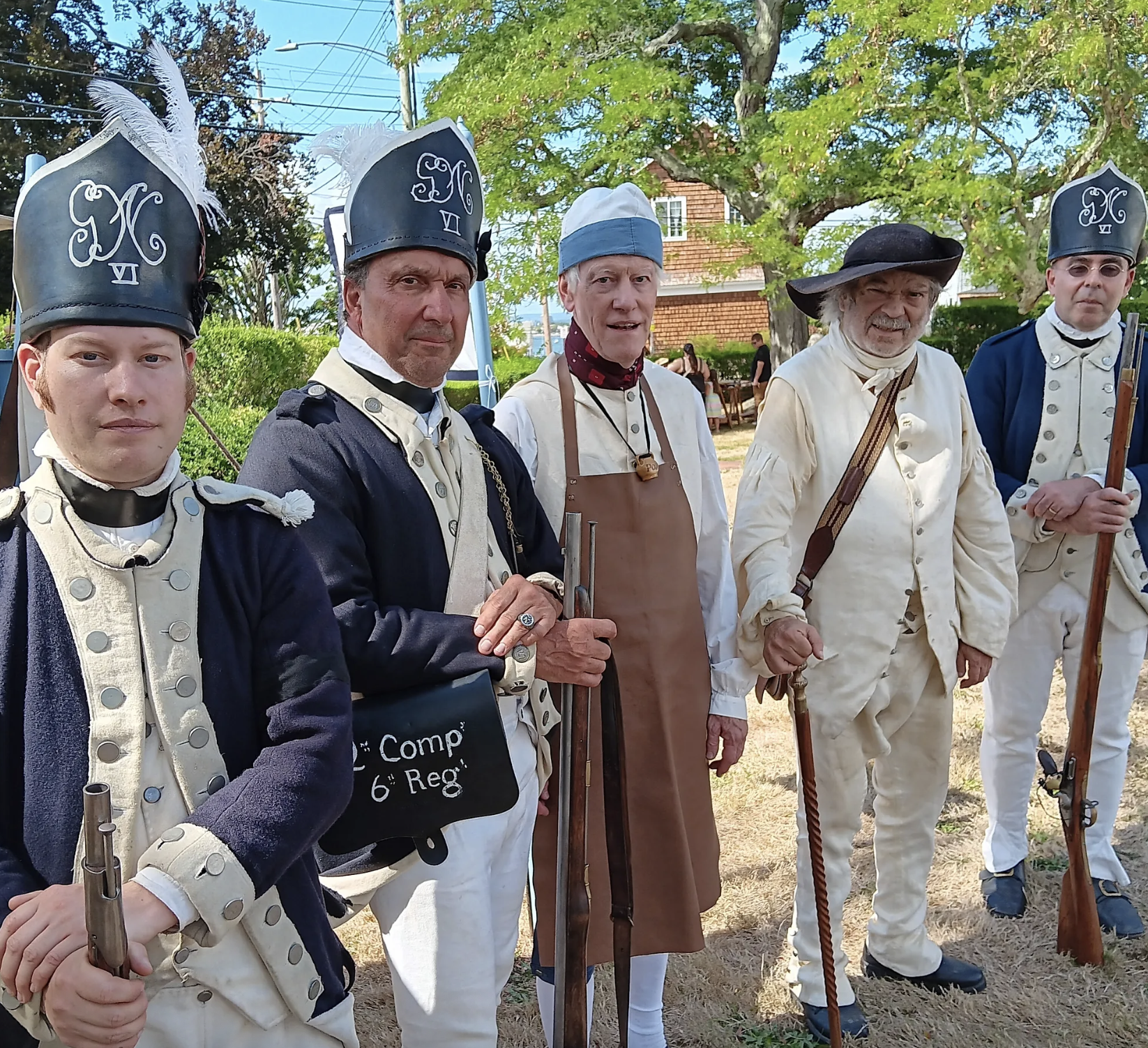By Allan Appel
Using all the powers of the modern press, a reporter had to coax Sgt. Robert Swift — of the Second Company, 6th Connecticut Regiment — that he really hailed not from New London, but from Lebanon, Connecticut; and furthermore that his real name is Frederick Rivard.
That reveal unfolded during the New Haven Museum’s annual four-hour family day of fun and colonial/Revolutionary era re-enactments at the historic Pardee-Morris House in Morris Cove.
There Swift and his half dozen fellow “Leatherheads,” as the company was known because of their cool (actually rather hot-looking) choice of head gear, helped visitors Sunday afternoon experience what it was like to live in Revolutionary War era Connecticut.
Re-enactors, explained Swift, choose a name of a real soldier from the rosters of those actually enlisted in the company in 1775, when the scrappy American patriots fought the British invaders. The quite serious protocol of re-enactors is also to stay in the clothing and in character as much as possible throughout an event.
In addition to a demonstration of loading and firing the smoky long muskets, how colonial militias drilled, and the scary surgical equipment of the field doctor if someone were wounded — demonstrated by Surgeon Beardsley, aka Bob Rivard, aka the dad of Swift/Rivard – yet another another impressively uniformed outfit, the famous Second Company Governors Foot Guard, was also in attendance.
Their job was to use music, with its unique time-traveling power to transport across time and space, so visitors might hear the actual sounds Swift, Beardsley and the other Revolutionary-era soldiers might have heard in an encampment on a cold, worrisome night in the forest.
The bracing drum and fife tunes were not only played during parades and formal ceremonies but had many uses in an encampment, said one of the group’s members, Kevin Chapin.
“There was a drum call to cut wood,” he said. “So the officers didn’t have to go about shouting. And another drum call to assemble the sergeants.”
And then there were the fifes, which, because they were so small, Chapin said, many soldiers carried as regular equipment, easily slipped in the pocket.
Chapin knows whereof he speaks, and, even more importantly, the powers of music to allay loneliness, fear, and homesickness because when not playing with the Foot Guard, he is the Elm City’s resident violin maker out of his historic home on Quinnipiac Avenue.
So while each company of soldiers, approximately 60 men, would have one assigned drummer and one fifer, many of the soldiers well might have chimed in for a chorus of fifes for entertainment.
And those fulfilling the formal music jobs were boys and young men, Chapin said, ranging from 12 to 18, he estimated. “If you were older than 18 you would likely be given a musket. But in an encampment you want music. Otherwise, it was miserable,” he added.
Meanwhile around the grassy lawn of the Pardee-Morris House kids were making tri-corner hats, playing at the hoop roll, and practicing their Jacob’s Ladder. That’s a wooden toy from the era where cascading blocks of wood appear to fall down a string.
New Haven Museum staffer Kyle Driebeek said that sometimes letters, numbers, or even Bible verses were written on the blocks, “anything they wanted the kids to memorize.”
Meanwhile back over at the little encampment under a white tent, Swift/Rivard and Private Ezra Foot, in this life Rick Schreiner of Derby, explained that one of the original 1775 members of the regiment was David Humphreys of Derby. That’s why the group, which attends as re-enactors as many as 40 to 50 events a year – and likely that will grow next year as America celebrates its 250th birthday — said the headquarters is in Derby.
Humphreys, who is buried at Grove Street Cemetery, was plucked out of the ranks of the regiment by none other than George Washington, whom he served as adjutant/assistant for the rest of the war.
Humphreys was not with the company when it participated in a daring raid, via whale boats, across Long Island Sound in 1777, when the group successfully attacked an English encampment at Sag Harbor, taking prisoners and burning ships in retaliation for the British burning of Danbury.
General David Wooster, who now has a gracious and important square named after him just east of Downtown, was killed in that action.
The re-enactors know their stuff.
New this year to the event was a colonial sutler. That’s a traveling peddler, literally a type of camp follower, who sold provisions to the soldiers. On Sunday beneath the canopy of a large tree, Steven Salisbury laid out his wares that attracted kids and grownups alike.
The press has it on good authority that Steven Salisbury is his own name, and his business is called Big Bear Trading. Even modern sutlers, however, very much adhered to standards of accuracy and staying in character, the re-enactors creed.
As he sold four beautiful black glass marbles to each of this reporter’s grandchildren, it was overheard that he keeps his phone with Venmo and other digital payment apps inside a hollowed out old 18th ‑century looking book.
The New Haven Museum/Pardee-Morris House Program Director Cynthia Riccio estimated that 100 people were transported, er, attended, the event.






